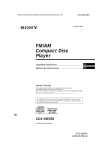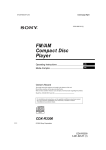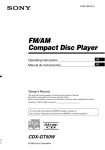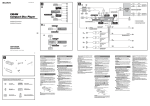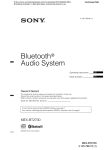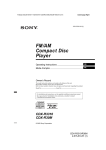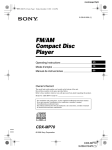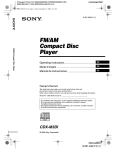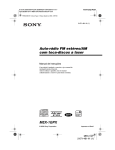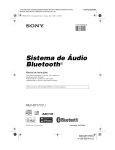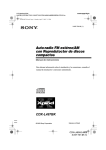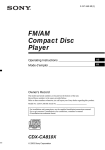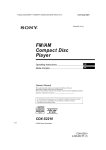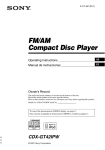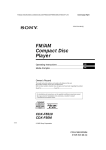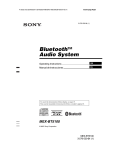Download Sony CDX-GT52W Operating Instructions
Transcript
F:\Data Disc\3217494611\3217494611CDXGT52W\01US+00COV-U.fm masterpage:Right 3-217-494-61 (1) FM/AM Compact Disc Player Operating Instructions US Manual de instrucciones ES Owner’s Record The model and serial numbers are located on the bottom of the unit. Record these numbers in the spaces provided below. Refer to these numbers whenever you call upon your Sony dealer regarding this product. Model No. Serial No. To cancel the demonstration (DEMO) display, see page 10. Para cancelar la pantalla de demostración (DEMO), consulte la página 10. CDX-GT52W © 2007 Sony Corporation CDX-GT52W 3-217-494-61 (1) F:\Data Disc\3217494611\3217494611CDXGT52W\01US01INT-U.fm masterpage:Left For installation and connections, see the supplied installation/connections manual. Warning This equipment has been tested and found to comply with the limits for a Class B digital device, pursuant to Part 15 of the FCC Rules. These limits are designed to provide reasonable protection against harmful interference in a residential installation. This equipment generates, uses, and can radiate radio frequency energy and, if not installed and used in accordance with the instructions, may cause harmful interference to radio communications. However, there is no guarantee that interference will not occur in a particular installation. If this equipment does cause harmful interference to radio or television reception, which can be determined by turning the equipment off and on, the user is encouraged to try to correct the interference by one or more of the following measures: – Reorient or relocate the receiving antenna. – Increase the separation between the equipment and receiver. – Connect the equipment into an outlet on a circuit different from that to which the receiver is connected. – Consult the dealer or an experienced radio/TV technician for help. You are cautioned that any changes or modifications not expressly approved in this manual could void your authority to operate this equipment. CAUTION The use of optical instruments with this product will increase eye hazard. For the state of california, USA only Perchlorate Material – special handling may apply, See www.dtsc.ca.gov/hazardouswaste/perchlorate Perchlorate Material: Lithium battery contains perchlorate The “HD Radio Ready” logo indicates that this product will control a Sony HD RadioTM tuner (sold separately). For HD RadioTM tuner operation, please refer to the HD RadioTM tuner Operating Instructions. The HD Radio Ready logo is a registered trademark of iBiquity. HD RadioTM is a trademark of iBiquity Digital Corp. The “SAT Radio Ready” logo indicates that this product will control a satellite radio tuner module (sold separately). Please see your nearest authorized Sony dealer for details on the satellite radio tuner module. “SAT Radio,” “SAT Radio Ready,” the SAT Radio and SAT Radio Ready logos and all related marks are trademarks of Sirius Satellite Radio Inc. and XM Satellite Radio Inc. Microsoft, Windows Media, and the Windows logo are trademarks or registered trademarks of Microsoft Corporation in the United States and/or other countries. Warning if your car’s ignition has no ACC position Be sure to set the Auto Off function (page 10). The unit will shut off completely and automatically in the set time after the unit is turned off, which prevents battery drain. If you do not set the Auto Off function, press and hold (OFF) until the display disappears each time you turn the ignition off. 2 CDX-GT52W 3-217-494-61 (1) F:\Data Disc\3217494611\3217494611CDXGT52W\01US+00COV-UTOC.fm masterpage:Right Table of Contents Welcome ! . . . . . . . . . . . . . . . . . . . . . . . . . . . . . 4 Additional Information Getting Started Precautions . . . . . . . . . . . . . . . . . . . . . . . . . . . Notes on discs . . . . . . . . . . . . . . . . . . . . . . Playback order of MP3/WMA/AAC files. . . . . . . . . . . . . . . . . . . . . . . . . . . . . . . About MP3 files . . . . . . . . . . . . . . . . . . . . . About WMA files. . . . . . . . . . . . . . . . . . . . About AAC files . . . . . . . . . . . . . . . . . . . . Maintenance . . . . . . . . . . . . . . . . . . . . . . . . . . Removing the unit. . . . . . . . . . . . . . . . . . . . . . Specifications . . . . . . . . . . . . . . . . . . . . . . . . . Troubleshooting . . . . . . . . . . . . . . . . . . . . . . . Error displays/Messages. . . . . . . . . . . . . . . Resetting the unit . . . . . . . . . . . . . . . . . . . . . . . . 4 Preparing the card remote commander . . . . . . . 4 Setting the clock . . . . . . . . . . . . . . . . . . . . . . . . 4 Detaching the front panel . . . . . . . . . . . . . . . . . 5 Attaching the front panel . . . . . . . . . . . . . . . 5 Inserting the disc in the unit . . . . . . . . . . . . . . . 5 Ejecting the disc . . . . . . . . . . . . . . . . . . . . . . 5 Location of controls and basic operations 12 12 13 13 13 14 14 14 15 16 17 Main unit. . . . . . . . . . . . . . . . . . . . . . . . . . . . 6 Card remote commander RM-X151 . . . . . . . 6 CD Display items . . . . . . . . . . . . . . . . . . . . . . . . 8 Repeat and shuffle play. . . . . . . . . . . . . . . . . 8 Radio Storing and receiving stations . . . . . . . . . . . . . . 8 Storing automatically — BTM . . . . . . . . . . . 8 Storing manually . . . . . . . . . . . . . . . . . . . . . . 8 Receiving the stored stations . . . . . . . . . . . . 8 Tuning automatically . . . . . . . . . . . . . . . . . . 8 Other functions Changing the sound settings . . . . . . . . . . . . . . . 9 Adjusting the sound characteristics . . . . . . . 9 Customizing the equalizer curve — EQ3 . . . . . . . . . . . . . . . . . . . . . . . . . . . . . 9 Adjusting setup items — SET . . . . . . . . . . . . . . 9 Using optional equipment . . . . . . . . . . . . . . . . 10 Auxiliary audio equipment . . . . . . . . . . . . . 10 CD/MD changer . . . . . . . . . . . . . . . . . . . . . 11 Rotary commander RM-X4S . . . . . . . . . . . 11 3 CDX-GT52W 3-217-494-61 (1) F:\Data Disc\3217494611\3217494611CDXGT52W\01US02CD-U.fm Welcome ! Getting Started Thank you for purchasing this Sony Compact Disc Player. You can enjoy your drive with the following functions. • CD playback You can play CD-DA (also containing CD TEXT) and CD-R/CD-RW (MP3/WMA/AAC files (page 13)). Type of discs masterpage:Left Label on the disc Resetting the unit Before operating the unit for the first time, or after replacing the car battery or changing the connections, you must reset the unit. Detach the front panel and press the RESET button with a pointed object, such as a ball-point pen. CD-DA MP3 WMA AAC RESET button Note Pressing the RESET button will erase the clock setting and some stored contents. Preparing the card remote commander • Radio reception – You can store up to 6 stations per band (FM1, FM2, FM3, AM1 and AM2). – BTM (Best Tuning Memory): The unit selects strong signal stations and stores them. • Sound adjustment – EQ3 stage2: You can choose any one of 7 preset equalizer curves. – DSO (Dynamic Soundstage Organizer): creates a more ambient sound field, using virtual speaker synthesis, to enhance the sound of speakers, even if they are installed low in the door. • Optional device operation You can also control optional device, such as CD/MD changers, etc. • Auxiliary equipment connection An AUX input jack on the front of the unit allows connection of a portable audio device. Before using the card remote commander for the first time, remove the insulation film. Tip For how to replace the battery, see “Replacing the lithium battery of the card remote commander” on page 14. Setting the clock The clock uses a 12-hour digital indication. 1 Press and hold the select button. The setup display appears. 2 Press the select button repeatedly until “CLOCK-ADJ” appears. 3 Press (SEEK) +. The hour indication flashes. 4 Rotate the volume control dial to set the hour and minute. To move the digital indication, press (SEEK) –/+. 5 Press the select button. The setup is complete and the clock starts. To display the clock, press (DSPL). Press (DSPL) again to return to the previous display. 4 CDX-GT52W 3-217-494-61 (1) F:\Data Disc\3217494611\3217494611CDXGT52W\01US02CD-U.fm Detaching the front panel You can detach the front panel of this unit to prevent theft. Caution alarm If you turn the ignition switch to the OFF position without detaching the front panel, the caution alarm will sound for a few seconds. The alarm will only sound if the built-in amplifier is used. 1 Press (OFF). The unit is turned off. 2 Press (OPEN). The front panel is flipped down. 3 Slide the front panel to the right, then gently pull out the left end of the front panel. masterpage:Right Note Do not put anything on the inner surface of the front panel. Inserting the disc in the unit 1 2 Press (OPEN). 3 Close the front panel. Playback starts automatically. Insert the disc (label side up). Ejecting the disc 1 2 1 2 Press (OPEN). 3 Close the front panel. Press Z. The disc is ejected. Notes • Do not drop or put excessive pressure on the front panel and display window. • Do not subject the front panel to heat/high temperature or moisture. Avoid leaving it in a parked car or on a dashboard/rear tray. Attaching the front panel Place the hole A of the front panel onto the spindle B on the unit, then lightly push the left side in. Press (SOURCE) on the unit (or insert a disc) to operate the unit. A B c 5 CDX-GT52W 3-217-494-61 (1) F:\Data Disc\3217494611\3217494611CDXGT52W\01US02CD-U.fm masterpage:Left Location of controls and basic operations Main unit 1 2 3 4 5 6 OPEN OFF ALBM SOURCE SEEK AUX SEEK ALBM MODE CAT BTM 1 2 REP SHUF 3 4 5 PAUSE SCRL 6 DSPL PUSH SELECT 7 8 9 q; qa qs qd Front panel removed qf qg qh RESET Card remote commander RM-X151 1 3 qj OFF SOURCE ATT SEL MODE w; wa q; + ws – qk ql SCRL DSPL 1 2 3 4 5 6 + VOL – wd wf This section contains instructions on the location of controls and basic operations. For details, see the respective pages. For optional device (CD/MD changer, etc.,) operation, see “Using optional equipment” on page 10. The corresponding buttons on the card remote commander control the same functions as those on the unit. A OFF button To power off; stop the source. B Volume control dial/select button page 9 To adjust volume (rotate); select setup items (press and rotate). C SOURCE button To power on; change the source (Radio/CD/ AUX)*. D Display window E AUX input jack page 10 To connect a portable audio device. 6 CDX-GT52W 3-217-494-61 (1) F:\Data Disc\3217494611\3217494611CDXGT52W\01US02CD-U.fm F OPEN button page 5 G ALBM +/– buttons (during MP3/WMA/ AAC playback) To skip albums (press); skip albums continuously (press and hold). H Receptor for the card remote commander I SEEK –/+ buttons CD: To skip tracks (press); skip tracks continuously (press, then press again within about 1 second and hold); reverse/fastforward a track (press and hold). Radio: To tune in stations automatically (press); find a station manually (press and hold). masterpage:Right The following buttons on the card remote commander have also different buttons/functions from the unit. Remove the insulation film before use (page 4). qj < (.)/, (>) buttons To control CD/radio, the same as (SEEK) –/+ on the unit. Setup, sound setting, etc., can be operated by < ,. qk DSPL (display) button To change display items. ql VOL (volume) +/– button To adjust volume. w; ATT (attenuate) button To attenuate the sound. To cancel, press again. J MODE button page 8 To select the radio band (FM/AM)*. wa SEL (select) button The same as the select button on the unit. K BTM/CAT button page 8 To start the BTM function (press and hold). ws M (+)/m (–) buttons To control CD, the same as (ALBM) +/– on the unit. Setup, sound setting, etc., can be operated by M m. L Number buttons CD: (3): REP page 8 (4): SHUF page 8 (6): PAUSE To pause playback of a CD on this unit. To cancel, press again. Radio: To receive stored stations (press); store stations (press and hold). M DSPL (display)/SCRL (scroll) button page 8 To change display items (press); scroll the display item (press and hold). N RESET button page 4 O Z (eject) button page 5 To eject the disc. P Disc slot page 5 To insert the disc. wd SCRL (scroll) button To scroll the display item. wf Number buttons To receive stored stations (press); store stations (press and hold). * In the case of a CD/MD changer or SAT tuner being connected; when (SOURCE) is pressed, the connected device (“MD,” “XM” or “SR”) will appear in the display, depending on which device is connected. Furthermore, if (MODE) is pressed, you can switch the changer, or SAT tuner band. Note If the unit is turned off and the display disappears, it cannot be operated with the card remote commander unless (SOURCE) on the unit is pressed, or a disc is inserted to activate the unit first. 7 CDX-GT52W 3-217-494-61 (1) F:\Data Disc\3217494611\3217494611CDXGT52W\01US02CD-U.fm CD masterpage:Left Radio For details on selecting a CD/MD changer, see page 11. Storing and receiving stations Caution Display items When tuning in stations while driving, use Best Tuning Memory (BTM) to prevent an accident. Storing automatically — BTM A Source B Track number/Elapsed playing time, Disc/ artist name, Album number*, Album name, Track name, Text information, Clock 1 Press (SOURCE) repeatedly until “TUNER” appears. To change the band, press (MODE) repeatedly. You can select from FM1, FM2, FM3, AM1 or AM2. 2 Press and hold (BTM) until “BTM” flashes. The unit stores stations in order of frequency on the number buttons. A beep sounds when the setting is stored. * Album number is displayed only when the album is changed. To change display items B, press (DSPL). Tip Displayed items will differ, depending on the disc type, recording format and settings. For details on MP3/ WMA/AAC, see page 13. Repeat and shuffle play 1 During playback, press (3) (REP) or (4) (SHUF) repeatedly until the desired setting appears. Select TRACK ALBUM* To play Storing manually 1 While receiving the station that you want to store, press and hold a number button ((1) to (6)) until “MEM” appears. Note If you try to store another station on the same number button, the previously stored station will be replaced. Receiving the stored stations 1 track repeatedly. Select the band, then press a number button ((1) to (6)). album repeatedly. SHUF ALBUM* album in random order. Tuning automatically SHUF DISC disc in random order. 1 * When an MP3/WMA/AAC is played. To return to normal play mode, select “ or “SHUF OFF.” OFF” Select the band, then press (SEEK) –/+ to search for the station. Scanning stops when the unit receives a station. Repeat this procedure until the desired station is received. Tip If you know the frequency of the station you want to listen to, press and hold (SEEK) –/+ to locate the approximate frequency, then press (SEEK) –/+ repeatedly to fine adjust to the desired frequency (manual tuning). 8 CDX-GT52W 3-217-494-61 (1) F:\Data Disc\3217494611\3217494611CDXGT52W\01US02CD-U.fm Other functions Changing the sound settings Adjusting the sound characteristics 1 Press the select button repeatedly until the desired item appears. 2 Rotate the volume control dial to adjust the selected item. After 3 seconds, the setting is complete and the display returns to normal play/reception mode. Customizing the equalizer curve — EQ3 “CUSTOM” of EQ3 allows you to make your own equalizer settings. 1 Select a source, then press the select button repeatedly to select “EQ3.” 2 Rotate the volume control dial to select “CUSTOM.” 3 Press the select button repeatedly until “LOW,” “MID” or “HI” appears. 4 Rotate the volume control dial to adjust the selected item. The volume level is adjustable in 1 dB steps, from –10 dB to +10 dB. The following items can be set (follow the page reference for details): “z” indicates the default settings. EQ3 To select an equalizer type: “XPLOD” (z), “VOCAL,” “EDGE,” “CRUISE,” “SPACE,” “GRAVITY,” “CUSTOM” or “OFF.” DSO To select the DSO mode: “1,” “2” (z), “3” or “OFF.” The larger the number, the more enhanced the effect. When tuner is selected as the source, the default setting is “OFF.” LOW*1, MID*1, HI*1 (page 9) To customize the equalizer curve. BAL (Balance) To adjust the balance between the right and left speakers: “RIGHT-10” – “CENTER” (z) – “LEFT-10” FAD (Fader) To adjust the balance between the front and rear speakers: “FRONT-10” – “CENTER” (z) – “REAR-10” SUB (Subwoofer volume) To adjust the subwoofer volume: “+10 dB” – “0 dB” (z) – “–10 dB” (“ATT” is displayed at the lowest setting.) AUX*2 (AUX level) To adjust the volume level for each connected auxiliary equipment. This setting negates the need to adjust the volume level between sources (page 10). Adjustable level: “+18 dB” – “0 dB” (z) – “–8 dB” *1 When EQ3 is activated. *2 When AUX source is activated. masterpage:Right Repeat steps 3 and 4 to adjust the equalizer curve. To restore the factory-set equalizer curve, press and hold the select button before the setting is complete. After 3 seconds, the setting is complete and the display returns to normal play/reception mode. Tip Other equalizer types are also adjustable. Adjusting setup items — SET 1 Press and hold the select button. The setup display appears. 2 Press the select button repeatedly until the desired item appears. 3 Rotate the volume control dial to select the setting (example “ON” or “OFF”). 4 Press and hold the select button. The setup is complete and the display returns to normal play/reception mode. Note Displayed items will differ, depending on the source and setting. The following items can be set (follow the page reference for details): “z” indicates the default settings. continue to next page t 9 CDX-GT52W 3-217-494-61 (1) F:\Data Disc\3217494611\3217494611CDXGT52W\01US02CD-U.fm CLOCK-ADJ (Clock Adjust) (page 4) BEEP To set “BEEP-ON” (z) or “BEEP-OFF.” AUX-A*1 (AUX Audio) To turn the AUX source display “AUX-A-ON” (z) or “AUX-A-OFF” (page 10). A.OFF (Auto Off) To shut off automatically after a desired time when the unit is turned off, – “A.OFF-NO” (z), “A.OFF-30S (Seconds),” “A.OFF-30M (Minutes)” or “A.OFF-60M (Minutes).” DEMO (Demonstration) To set “DEMO-ON” (z) or “DEMO-OFF.” DIMMER To change the brightness of the display. – “DIMMER-ON”: to dim the display. – “DIMMER-OFF” (z): to deactivate the dimmer. CONTRAST To adjust the contrast of the display. The contrast level is adjustable in 7 steps. M.DSPL (Motion Display) To select the Motion Display mode. – “M.DSPL-SA” (z): to show moving patterns and spectrum analyzer. – “M.DSPL-ON”: to show moving patterns. – “M.DSPL-OFF”: to deactivate the Motion Display. A.SCRL (Auto Scroll) To scroll long displayed item automatically when the disc/album/track is changed. – “A.SCRL-ON” (z): to scroll. – “A.SCRL-OFF”: to not scroll. LOCAL (Local Seek Mode) – “LOCAL-ON” : to only tune into stations with stronger signals. – “LOCAL-OFF” (z): to tune normal reception. MONO*2 (Monaural Mode) To improve poor FM reception, select monaural reception mode. – “MONO-ON” : to hear stereo broadcast in monaural. – “MONO-OFF” (z): to hear stereo broadcast in stereo. LPF (Low Pass Filter) To select the subwoofer cut-off frequency: “LPF OFF” (z), “LPF125Hz” or “LPF 78Hz.” LOUD (Loudness) To allow you to listen clearly at low volume levels. – “LOUD-ON” : to reinforce bass and treble. – “LOUD-OFF” (z): to not reinforce bass and treble. masterpage:Left BTM (page 8) *1 When the unit is turned off. *2 When FM is received. Using optional equipment Auxiliary audio equipment By connecting an optional portable audio device to the AUX input jack (stereo mini jack) on the unit and then simply selecting the source, you can listen on your car speakers. The volume level is adjustable for any difference between the unit and the portable audio device. Follow the procedure below: Connecting the portable audio device 1 Turn off the portable audio device. 2 Turn down the volume on the unit. 3 Connect to the unit. AUX AUX Connecting cord* (not supplied) * Be sure to use a straight type plug. Adjust the volume level Be sure to adjust the volume for each connected audio device before playback. 1 Turn down the volume on the unit. 2 Press (SOURCE) repeatedly until “AUX” appears. “AUX FRONT IN” appears. 3 Start playback of the portable audio device at a moderate volume. 4 Set your usual listening volume on the unit. 5 Adjust the input level (page 9). 10 CDX-GT52W 3-217-494-61 (1) F:\Data Disc\3217494611\3217494611CDXGT52W\01US02CD-U.fm masterpage:Right CD/MD changer Rotary commander RM-X4S Selecting the changer Attaching the label 1 Press (SOURCE) repeatedly until “CD” or “MD” appears. 2 Press (MODE) repeatedly until the desired changer appears. Attach the indication label depending on how you mount the rotary commander. Unit number DSPL MODE SEL SEL MODE DSPL Location of controls The corresponding buttons on the rotary commander control the same functions as those on this unit. Disc number Playback starts. ATT SEL Skipping albums and discs PRESET/ DISC 1 During playback, press (ALBM) +/–. Press (ALBM) album and release (hold for a moment). album continuously within 2 seconds of first releasing. discs repeatedly. discs continuously then, press again within 2 seconds and hold. SOURCE DSPL VOL 1 During playback, press (3) (REP) or (4) (SHUF) repeatedly until the desired setting appears. DISC To play disc repeatedly. SHUF CHANGER tracks in the changer in random order. SHUF ALL* tracks in all units in random order. * When one or more CD changers, or two or more MD changers are connected. To return to normal play mode, select “ or “SHUF OFF.” SEEK/AMS OFF The following controls on the rotary commander require a different operation from the unit. Repeat and shuffle play Select MODE OFF To skip • ATT (attenuate) button To attenuate the sound. To cancel, press again. • DSPL (display) button To change display items. • PRESET/DISC control The same as (ALBM) +/– on the unit (push in and rotate). • VOL (volume) control The same as the volume control dial on the unit (rotate). • SEEK/AMS control The same as (SEEK) –/+ on the unit (rotate, or rotate and hold). Changing the operative direction The operative direction of the controls is factoryset as shown below. To increase OFF” Tip “SHUF ALL” will not shuffle tracks between CD units and MD changers. To decrease If you need to mount the rotary commander on the right hand side of the steering column, you can reverse the operative direction. continue to next page t 11 CDX-GT52W 3-217-494-61 (1) F:\Data Disc\3217494611\3217494611CDXGT52W\01US02CD-U.fm 1 While pushing the VOL control, press and hold (SEL). masterpage:Left Additional Information Precautions • If your car has been parked in direct sunlight, allow the unit to cool off before operating it. • Power antenna (aerial) will extend automatically while the unit is operating. Moisture condensation On a rainy day or in a very damp area, moisture condensation may occur inside the lenses and display of the unit. Should this occur, the unit will not operate properly. In such a case, remove the disc and wait for about an hour until the moisture has evaporated. To maintain high sound quality Be careful not to splash juice or other soft drinks onto the unit or discs. Notes on discs • To keep a disc clean, do not touch its surface. Handle the disc by its edge. • Keep your discs in their cases or disc magazines when not in use. • Do not subject discs to heat/high temperature. Avoid leaving them in a parked car or on a dashboard/rear tray. • Do not attach labels, or use discs with sticky ink/ residue. Such discs may stop spinning when used, causing a malfunction, or may ruin the disc. • Do not use any discs with labels or stickers attached. The following malfunctions may result from using such discs: – Inability to eject a disc (due to a label or sticker peeling off and jamming the eject mechanism). – Inability to read audio data correctly (e.g., playback skipping, or no playback) due to heat shrinking of a sticker or label causing a disc to warp. • Discs with non-standard shapes (e.g., heart, square, star) cannot be played on this unit. Attempting to do so may damage the unit. Do not use such discs. • You cannot play 8 cm (3 1/4 in) CDs. 12 CDX-GT52W 3-217-494-61 (1) F:\Data Disc\3217494611\3217494611CDXGT52W\01US02CD-U.fm • Before playing, clean the discs with a commercially available cleaning cloth. Wipe each disc from the center out. Do not use solvents such as benzine, thinner, commercially available cleaners, or antistatic spray intended for analog discs. masterpage:Right Playback order of MP3/WMA/AAC files MP3/WMA/AAC Folder (album) MP3/WMA/ AAC file (track) Notes on CD-R/CD-RW discs • Some CD-Rs/CD-RWs (depending on the equipment used for its recording or the condition of the disc) may not play on this unit. • You cannot play a CD-R/a CD-RW that is not finalized. • The unit is compatible with the ISO 9660 level 1/ level 2 format, Joliet/Romeo in the expansion format, and Multi Session. • The maximum number of: – folders (albums): 150 (including root and empty folders). – files (tracks) and folders contained in a disc: 300 (if a folder/file names contain many characters, this number may become less than 300). – displayable characters for a folder/file name is 32 (Joliet), or 64 (Romeo). • When the disc is recorded in Multi Session, only the first track of the first session format is recognized and played (any other format is skipped). The priority of the format is CD-DA and MP3/WMA/AAC. – When the first track is a CD-DA, only CD-DA of the first session is played. – When the first track is not a CD-DA, the MP3/ WMA/AAC session is played. If the disc has no data in any of these formats, “NO MUSIC” is displayed. Music discs encoded with copyright protection technologies About MP3 files • MP3, which stands for MPEG-1 Audio Layer-3, is a music file compression format standard. It compresses audio CD data to approximately 1/10 of its original size. • ID3 tag versions 1.0, 1.1, 2.2, 2.3 and 2.4 apply to MP3 only. ID3 tag is 15/30 characters (1.0 and 1.1), or 63/126 characters (2.2, 2.3 and 2.4). • When naming an MP3 file, be sure to add the file extension “.mp3” to the file name. • During playback or fast-forward/reverse of a VBR (variable bit rate) MP3 file, elapsed playing time may not display accurately. Note If you play a high-bit-rate MP3, such as 320 kbps, sound may be intermittent. About WMA files This product is designed to play back discs that conform to the Compact Disc (CD) standard. Recently, various music discs encoded with copyright protection technologies are marketed by some record companies. Please be aware that among those discs, there are some that do not conform to the CD standard and may not be playable by this product. • WMA, which stands for Windows Media Audio, is a music file compression format standard. It compresses audio CD data to approximately 1/22* of its original size. • WMA tag is 63 characters. • When naming a WMA file, be sure to add the file extension “.wma” to the file name. • During playback or fast-forward/reverse of a VBR (variable bit rate) WMA file, elapsed playing time may not display accurately. Note on DualDiscs * only for 64 kbps A DualDisc is a two sided disc product which mates DVD recorded material on one side with digital audio material on the other side. However, since the audio material side does not conform to the Compact Disc (CD) standard, playback on this product is not guaranteed. Note Playback of the following WMA files is not supported. – lossless compression – copyright-protected 13 CDX-GT52W 3-217-494-61 (1) F:\Data Disc\3217494611\3217494611CDXGT52W\01US02CD-U.fm masterpage:Left Fuse replacement About AAC files • AAC, which stands for Advanced Audio Coding, is a music file compression format standard. It compresses audio CD data to approximately 1/11* of its original size. • AAC tag is 126 characters. • When naming an AAC file, be sure to add the file extension “.m4a” to the file name. • During playback or fast-forward/reverse of a VBR (variable bit rate) AAC file, elapsed playing time may not display accurately. * only for 128 kbps Note on AAC Playback of a copyright-protected file is not supported. If you have any questions or problems concerning your unit that are not covered in this manual, consult your nearest Sony dealer. When replacing the fuse, be sure to use one matching the amperage rating stated on the original fuse. If the fuse blows, check the power connection and replace the fuse. If the fuse blows again after replacement, there may be an internal malfunction. In such a case, consult your nearest Sony dealer. Fuse (10 A) Cleaning the connectors The unit may not function properly if the connectors between the unit and the front panel are not clean. In order to prevent this, detach the front panel (page 5) and clean the connectors with a cotton swab. Do not apply too much force. Otherwise, the connectors may be damaged. Maintenance Replacing the lithium battery of the card remote commander Under normal conditions, the battery will last approximately 1 year. (The service life may be shorter, depending on the conditions of use.) When the battery becomes weak, the range of the card remote commander becomes shorter. Replace the battery with a new CR2025 lithium battery. Use of any other battery may present a risk of fire or explosion. + side up 2 c 1 Notes on the lithium battery • Keep the lithium battery out of the reach of children. Should the battery be swallowed, immediately consult a doctor. • Wipe the battery with a dry cloth to assure a good contact. • Be sure to observe the correct polarity when installing the battery. • Do not hold the battery with metallic tweezers, otherwise a short-circuit may occur. WARNING Battery may explode if mistreated. Do not recharge, disassemble, or dispose of in fire. Back of the front panel Main unit Notes • For safety, turn off the ignition before cleaning the connectors, and remove the key from the ignition switch. • Never touch the connectors directly with your fingers or with any metal device. Removing the unit 1 Remove the protection collar. 1 Detach the front panel (page 5). 2 Pinch both edges of the protection collar, then pull it out. x 14 CDX-GT52W 3-217-494-61 (1) F:\Data Disc\3217494611\3217494611CDXGT52W\01US02CD-U.fm 2 Remove the unit. Tuner section 1 Insert both release keys simultaneously until they click. FM Hook facing inwards. 2 Pull the release keys to unseat the unit. masterpage:Right Tuning range: 87.5 – 107.9 MHz Antenna (aerial) terminal: External antenna (aerial) connector Intermediate frequency: 10.7 MHz/450 kHz Usable sensitivity: 9 dBf Selectivity: 75 dB at 400 kHz Signal-to-noise ratio: 67 dB (stereo), 69 dB (mono) Harmonic distortion at 1 kHz: 0.5 % (stereo), 0.3 % (mono) Separation: 35 dB at 1 kHz Frequency response: 30 – 15,000 Hz AM Tuning range: 530 – 1,710 kHz Antenna (aerial) terminal: External antenna (aerial) connector Intermediate frequency: 10.7 MHz/450 kHz Sensitivity: 30 µV Power amplifier section 3 Slide the unit out of the mounting. Outputs: Speaker outputs (sure seal connectors) Speaker impedance: 4 – 8 ohms Maximum power output: 52 W × 4 (at 4 ohms) General Specifications AUDIO POWER SPECIFICATIONS POWER OUTPUT AND TOTAL HARMONIC DISTORTION 23.2 watts per channel minimum continuous average power into 4 ohms, 4 channels driven from 20 Hz to 20 kHz with no more than 5% total harmonic distortion. CEA2006 Standard Power Output: 17 Watts RMS × 4 at 4 Ohms < 1% THD+N SN Ratio: 82 dBA (reference: 1 Watt into 4 Ohms) CD Player section Signal-to-noise ratio: 120 dB Frequency response: 10 – 20,000 Hz Wow and flutter: Below measurable limit Output: Audio outputs terminal (front/rear) Subwoofer output terminal (mono) Power antenna (aerial) relay control terminal Power amplifier control terminal Inputs: BUS control input terminal BUS audio input terminal Remote controller input terminal Antenna (aerial) input terminal AUX input jack (stereo mini jack) Tone controls: Low: ±10 dB at 60 Hz (XPLOD) Mid: ±10 dB at 1 kHz (XPLOD) High: ±10 dB at 10 kHz (XPLOD) Power requirements: 12 V DC car battery (negative ground (earth)) Dimensions: Approx. 178 × 50 × 180 mm (7 1/8 × 2 × 7 1/8 in) (w/h/d) Mounting dimensions: Approx. 182 × 53 × 162 mm (7 1/4 × 2 1/8 × 6 1/2 in) (w/h/d) Mass: Approx. 1.2 kg (2 lb 11 oz) Supplied accessories: Card remote commander: RM-X151 Parts for installation and connections (1 set) Optional accessories/equipment: Rotary commander: RM-X4S BUS cable (supplied with an RCA pin cord): RC-61 (1 m), RC-62 (2 m) CD changer (10 discs): CDX-757MX CD changer (6 discs): CDX-T69 Source selector: XA-C40 AUX-IN selector: XA-300 Interface adaptor for iPod: XA-120IP HD Radio™ tuner: XT-100HD continue to next page t 15 CDX-GT52W 3-217-494-61 (1) F:\Data Disc\3217494611\3217494611CDXGT52W\01US02CD-U.fm Your dealer may not handle some of the above listed accessories. Please ask the dealer for detailed information. MPEG Layer-3 audio coding technology and patents licensed from Fraunhofer IIS and Thomson. Design and specifications are subject to change without notice. • Halogenated flame retardants are not used in the certain printed wiring boards. • Halogenated flame retardants are not used in cabinets. • Packaging cushions are made from paper. Troubleshooting The following checklist will help you remedy problems you may encounter with your unit. Before going through the checklist below, check the connection and operating procedures. General No power is being supplied to the unit. • Check the connection. If everything is in order, check the fuse. • If the unit is turned off and the display disappears, it cannot be operated with the remote commander. t Turn on the unit. The power antenna (aerial) does not extend. The power antenna (aerial) does not have a relay box. No sound. • The volume is too low. • The ATT function is activated. • The position of the fader control “FAD” is not set for a 2-speaker system. • The CD changer is incompatible with the disc format (MP3/WMA/AAC). t Play back with a Sony MP3 compatible CD changer, or this unit. No beep sound. • The beep sound is canceled (page 10). • An optional power amplifier is connected and you are not using the built-in amplifier. The contents of the memory have been erased. • The RESET button has been pressed. t Store again into the memory. • The power supply lead or battery has been disconnected. • The power supply lead is not connected properly. masterpage:Left Stored stations and correct time are erased. The fuse has blown. Makes noise when the position of the ignition is switched. The leads are not matched correctly with the car’s accessory power connector. During playback or reception, demonstration mode starts. If no operation is performed for 5 minutes with “DEMO-ON” set, demonstration mode starts. t Set “DEMO-OFF” (page 10). The display disappears from/does not appear in the display window. • The dimmer is set “DIMMER-ON” (page 10). • The display disappears if you press and hold (OFF). t Press and hold (OFF) on the unit until the display appears. • The connectors are dirty (page 14). The Auto Off function does not operate. The unit is turned on. The Auto Off function activates after turning off the unit. t Turn off the unit. Card remote commander operation is not possible. Make sure the insulation film has been removed (page 4). DSO does not function. Depending on the type of car interior or type of music, DSO may not have a desirable effect. CD/MD playback The disc cannot be loaded. • Another disc is already loaded. • The disc has been forcibly inserted upside down or in the wrong way. The disc does not playback. • Defective or dirty disc. • The CD-Rs/CD-RWs are not for audio use (page 13). MP3/WMA/AAC files cannot be played back. The disc is incompatible with the MP3/WMA/AAC format and version (page 13). MP3/WMA/AAC files take longer to play back than others. The following discs take a longer time to start playback. – a disc recorded with a complicated tree structure. – a disc recorded in Multi Session. – a disc to which data can be added. The display items do not scroll. • For discs with very many characters, those may not scroll. • “A.SCRL” is set to “OFF”. t Set “A.SCRL-ON” (page 10). t Press and hold (DSPL) (SCRL). The sound skips. • Installation is not correct. t Install the unit at an angle of less than 45° in a sturdy part of the car. • Defective or dirty disc. 16 CDX-GT52W 3-217-494-61 (1) F:\Data Disc\3217494611\3217494611CDXGT52W\01US02CD-U.fm The operation buttons do not function. The disc will not eject. Press the RESET button (page 4). Radio reception The stations cannot be received. The sound is hampered by noises. • Connect a power antenna (aerial) control lead (blue) or accessory power supply lead (red) to the power supply lead of a car’s antenna (aerial) booster (only when your car has built-in FM/AM antenna (aerial) in the rear/side glass). • Check the connection of the car antenna (aerial). • The auto antenna (aerial) will not go up. t Check the connection of the power antenna (aerial) control lead. • Check the frequency. • When the DSO mode is on, the sound is sometimes hampered by noises. t Set the DSO mode to “OFF” (page 9). Preset tuning is not possible. • Store the correct frequency in the memory. • The broadcast signal is too weak. Automatic tuning is not possible. • Setting of the local seek mode is not correct. t Tuning stops too frequently: Set “LOCAL-ON” (page 10). t Tuning does not stop at a station: Set “MONO-ON” (page 10). • The broadcast signal is too weak. t Perform manual tuning. During FM reception, the “ST” indication flashes. • Tune in the frequency accurately. • The broadcast signal is too weak. t Set “MONO-ON” (page 10). An FM program broadcast in stereo is heard in monaural. The unit is in monaural reception mode. t Set “MONO-OFF” (page 10). Error displays/Messages BLANK Tracks have not been recorded on the MD.*1 t Play an MD with recorded tracks. ERROR*2 • The disc is dirty or inserted upside down.*1 t Clean or insert the disc correctly. • A blank disc has been inserted. • The disc cannot play due to a problem. t Insert another disc. masterpage:Right FAILURE (Illuminates until any button is pressed.) The connection of speakers/amplifiers is incorrect. t See the installation/connections manual of this model to check the connection. FAILURE (Illuminates for about 1 second.) When the SAT tuner is connected, storing an SAT radio channel into a preset failed. t Be sure to receive the channel that you want to store, then try it again. LOAD The changer is loading the disc. t Wait until loading is complete. L. SEEK +/– The local seek mode is on during automatic tuning. NO DISC The disc is not inserted in the CD/MD changer. t Insert discs in the changer. NO INFO Text information is not written in the MP3/WMA/ AAC file. NO MAG The disc magazine is not inserted in the CD changer. t Insert the magazine in the changer. NO MUSIC The disc does not contain a music file. t Insert a music CD in this unit or MP3 playable changer. NO NAME A disc/track name is not written in the track. NOTREADY The lid of the MD changer is open or the MDs are not inserted properly. t Close the lid or insert the MDs properly. OFFSET There may be an internal malfunction. t Check the connection. If the error indication remains on in the display, consult your nearest Sony dealer. READ The unit is reading all track and album information on the disc. t Wait until reading is complete and playback starts automatically. Depending on the disc structure, it may take more than a minute. RESET The CD unit and CD/MD changer cannot be operated due to a problem. t Press the RESET button (page 4). “ ” or “ ” During reverse or fast-forward, you have reached the beginning or the end of the disc and you cannot go any further. continue to next page t 17 CDX-GT52W 3-217-494-61 (1) F:\Data Disc\3217494611\3217494611CDXGT52W\01US02CD-U.fm masterpage:Left “ ” The character cannot be displayed with the unit. *1 The disc number of the disc causing the error appears in the display. *2 If an error occurs during playback of a CD or MD, the disc number of the CD or MD does not appear in the display. If these solutions do not help improve the situation, consult your nearest Sony dealer. If you take the unit to be repaired because of CD playback trouble, bring the disc that was used at the time the problem began. 18 CDX-GT52W 3-217-494-61 (1) F:\Data Disc\3217494611\3217494611CDXGT52W\01US02CD-U.fm masterpage:None CDX-GT52W 3-217-494-61 (1) F:\Data Disc\3217494611\3217494611CDXGT52W\02ES01INT-U.fm Para obtener información sobre la instalación y las conexiones, consulte el manual de instalación/conexiones suministrado. El logotipo “HD Radio Ready” indica que este producto controlará un sintonizador HD RadioTM de Sony (se vende por separado). Para obtener información acerca del funcionamiento del sintonizador HD RadioTM, consulte el manual de instrucciones del sintonizador HD RadioTM. masterpage:Left Advertencia: si el encendido del automóvil no dispone de una posición ACC Asegúrese de ajustar la función de desconexión automática (página 10). La unidad se desconectará completa y automáticamente en el tiempo establecido después de apagarla, lo cual evita que se agote la batería. Si no ajusta la función de desconexión automática, mantenga presionado (OFF) hasta que la pantalla se apague cada vez que apague el motor. El logo HD Radio Ready es una marca registrada de iBiquity. HD RadioTM es una marca registrada de iBiquity Digital Corp. El logotipo “SAT Radio Ready” indica que este producto controla un módulo de sintonizador de radio por satélite (se vende por separado). Si desea obtener más detalles sobre el módulo de sintonizador de radio por satélite, póngase en contacto con el distribuidor Sony autorizado más cercano. “SAT Radio”, “SAT Radio Ready”, los logotipos de SAT Radio, SAT Radio Ready y todas las marcas relacionadas son marcas comerciales de Sirius Satellite Radio Inc. y XM Satellite Radio Inc. Microsoft, Windows Media y el logotipo de Windows son marcas comerciales o marcas comerciales registradas de Microsoft Corporation en Estados Unidos o en otros países. 2 CDX-GT52W 3-217-494-61 (1) F:\Data Disc\3217494611\3217494611CDXGT52W\02ES+00COV-UTOC.fm masterpage:Right Tabla de contenido Bienvenido. . . . . . . . . . . . . . . . . . . . . . . . . . . . . 4 Información complementaria Procedimientos iniciales Precauciones . . . . . . . . . . . . . . . . . . . . . . . . . . Notas sobre los discos . . . . . . . . . . . . . . . . Orden de reproducción de los archivos MP3/WMA/AAC . . . . . . . . . . . . . . . . . . . . Acerca de los archivos MP3. . . . . . . . . . . . Acerca de los archivos WMA . . . . . . . . . . Acerca de los archivos AAC . . . . . . . . . . . Mantenimiento . . . . . . . . . . . . . . . . . . . . . . . . Extracción de la unidad. . . . . . . . . . . . . . . . . . Especificaciones . . . . . . . . . . . . . . . . . . . . . . . Solución de problemas . . . . . . . . . . . . . . . . . . Mensajes/indicaciones de error . . . . . . . . . Restauración de la unidad . . . . . . . . . . . . . . . . . 4 Preparación del control remoto de tarjeta . . . . . 4 Ajuste del reloj . . . . . . . . . . . . . . . . . . . . . . . . . 4 Extracción del panel frontal. . . . . . . . . . . . . . . . 5 Colocación del panel frontal . . . . . . . . . . . . . 5 Inserción del disco en la unidad . . . . . . . . . . . . 5 Expulsión del disco . . . . . . . . . . . . . . . . . . . . 5 Ubicación de los controles y operaciones básicas 13 13 14 14 14 14 14 15 16 16 18 Unidad principal . . . . . . . . . . . . . . . . . . . . . . 6 Control remoto de tarjeta RM-X151. . . . . . . 6 CD Elementos de la pantalla . . . . . . . . . . . . . . . . 8 Reproducción repetida y aleatoria . . . . . . . . 8 Radio Almacenamiento y recepción de emisoras . . . . 8 Almacenamiento automático — BTM. . . . . . . . . . . . . . . . . . . . . . . . . . . . . 8 Almacenamiento manual . . . . . . . . . . . . . . . 8 Recepción de las emisoras almacenadas. . . . 8 Sintonización automática . . . . . . . . . . . . . . . 9 Otras funciones Cambio de los ajustes de sonido . . . . . . . . . . . . 9 Ajuste de las características de sonido . . . . . 9 Personalización de la curva de ecualizador — EQ3 . . . . . . . . . . . . . . . . . . . . . . . . . . . . 10 Definición de los elementos de configuración — SET . . . . . . . . . . . . . . . . . . . . . . . . . . . . . . . 10 Uso de un equipo opcional . . . . . . . . . . . . . . . 11 Equipo auxiliar de audio . . . . . . . . . . . . . . . 11 Cambiador de CD/MD . . . . . . . . . . . . . . . . 11 Mando rotatorio RM-X4S. . . . . . . . . . . . . . 12 3 CDX-GT52W 3-217-494-61 (1) F:\Data Disc\3217494611\3217494611CDXGT52W\02ES02CD-U.fm Bienvenido Procedimientos iniciales Gracias por adquirir este reproductor de discos compactos Sony. Mientras maneja puede disfrutar de las funciones siguientes. • Reproducción de CD Puede reproducir discos CD-DA (incluidos CD TEXT) y CD-R/CD-RW (archivos MP3/WMA/ AAC incluidos también Multi Session (página 14)). Tipos de discos masterpage:Left Restauración de la unidad Antes de utilizar la unidad por primera vez, o después de sustituir la batería del automóvil o de cambiar las conexiones, debe restaurarla. Extraiga el panel frontal y presione el botón RESET con un objeto puntiagudo, como por ejemplo un bolígrafo. Etiqueta del disco Botón RESET CD-DA Nota Al presionar el botón RESET, se borrará el ajuste del reloj y algunos contenidos memorizados. MP3 WMA AAC • Recepción de radio – Puede almacenar hasta 6 emisoras de radio por banda (FM1, FM2, FM3, AM1 y AM2). – BTM (Memoria de la mejor sintonía): la unidad selecciona las emisoras que emiten la señal más intensa y las almacena. • Ajuste del sonido – EQ3 stage2: es posible seleccionar entre 7 curvas de ecualizador de valor predefinido. – DSO (Organizador de sonido de baja frecuencia dinámico): permite crear un campo de sonido más ambiental, utilizando una síntesis de altavoces virtuales para mejorar el sonido de los altavoces, incluso si éstos están instalados en una posición baja en la puerta. • Funcionamiento de una unidad opcional También puede controlar dispositivos opcionales como, por ejemplo, cambiadores de CD/MD, etc. • Conexión de equipos auxiliares La toma de entrada AUX situada en la parte frontal de la unidad permite conectar dispositivos de audio portátiles. Preparación del control remoto de tarjeta Antes de utilizar el control remoto de tarjeta por primera vez, retire la lámina de aislamiento. Sugerencia Si desea obtener información adicional sobre cómo sustituir la pila, consulte “Sustitución de la pila de litio del control remoto de tarjeta” en la página 14. Ajuste del reloj El reloj emplea una indicación digital de 12 horas. 1 Mantenga presionado el botón de selección. Aparecerá la pantalla de ajustes. 2 Presione el botón de selección varias veces hasta que aparezca “CLOCKADJ”. 3 Presione (SEEK) +. La indicación de la hora parpadea. 4 Gire el selector de control de volumen para ajustar la hora y los minutos. Para mover la indicación digital, presione (SEEK) –/+. 4 CDX-GT52W 3-217-494-61 (1) F:\Data Disc\3217494611\3217494611CDXGT52W\02ES02CD-U.fm 5 Presione el botón de selección. El ajuste se completa y el reloj se pone en funcionamiento. Para mostrar el reloj, presione (DSPL). Vuelva a presionar (DSPL) para regresar a la pantalla anterior. masterpage:Right Colocación del panel frontal Coloque el orificio A del panel frontal en el eje B de la unidad y, a continuación, presione ligeramente el lado izquierdo hacia adentro. Presione (SOURCE) en la unidad (o inserte un disco) para utilizarla. Extracción del panel frontal A Puede extraer el panel frontal de la unidad para evitar que la roben. B Alarma de precaución Si gira el interruptor de encendido hasta la posición OFF sin haber extraído el panel frontal, la alarma de precaución sonará durante unos segundos. La alarma sonará solamente si se utiliza el amplificador incorporado. 1 Presione (OFF). La unidad se apaga. 2 Presione (OPEN). El panel frontal se voltea hacia abajo. 3 Deslice el panel frontal hacia la derecha y tire suavemente de su extremo izquierdo. c Nota No coloque ningún objeto sobre la superficie interior del panel frontal. Inserción del disco en la unidad 1 2 Presione (OPEN). 3 Cierre el panel frontal. La reproducción se inicia automáticamente. Inserte el disco (con la etiqueta orientada hacia arriba). 1 2 Notas • No deje caer ni ejerza excesiva presión sobre el panel frontal ni la pantalla. • No someta el panel frontal al calor ni a temperaturas altas o excesiva humedad. Evite dejarlo en un automóvil estacionado o sobre el tablero o la bandeja trasera. Expulsión del disco 1 2 Presione (OPEN). 3 Cierre el panel frontal. Presione Z. El disco se expulsa. 5 CDX-GT52W 3-217-494-61 (1) F:\Data Disc\3217494611\3217494611CDXGT52W\02ES02CD-U.fm masterpage:Left Ubicación de los controles y operaciones básicas Unidad principal 1 2 3 4 5 6 OPEN OFF ALBM SOURCE SEEK AUX SEEK ALBM MODE CAT BTM 1 2 REP SHUF 3 4 5 PAUSE SCRL 6 DSPL PUSH SELECT 7 8 9 q; qa qs qd Panel frontal extraído qf qg qh RESET Control remoto de tarjeta RM-X151 1 3 qj OFF SOURCE ATT SEL MODE w; wa q; + ws – qk ql 6 SCRL DSPL 1 2 3 4 5 6 + VOL – wd wf Este apartado contiene instrucciones acerca de la ubicación de los controles y las operaciones básicas. Si desea obtener más información, consulte las páginas correspondientes. Si desea obtener más información acerca del funcionamiento con un dispositivo opcional (cambiador de CD/MD, etc.), consulte “Uso de un equipo opcional” en la página 11. Los botones correspondientes en el control remoto de tarjeta controlan las mismas funciones que los de la unidad. A Botón OFF Para apager la unidad o detener la fuente. B Selector de control de volumen/botón de selección página 9 Para ajustar el volumen (girar); para seleccionar elementos de configuración (presionar y girar). C Botón SOURCE Para encender; para cambiar la fuente (Radio/CD/AUX)*. D Visualizador CDX-GT52W 3-217-494-61 (1) F:\Data Disc\3217494611\3217494611CDXGT52W\02ES02CD-U.fm E Toma de entrada AUX página 11 Para conectar un dispositivo de audio portátil. F Botón OPEN página 5 G Botones ALBM +/– (durante la reproducción de archivos MP3/WMA/AAC) Para omitir álbumes (presionar); para omitir álbumes en forma continua (mantener presionado). H Receptor del control remoto de tarjeta I Botones SEEK –/+ CD: Para omitir pistas (presionar); para omitir pistas en forma continua (presionar y volver a presionar dentro de 1 segundo y mantener presionado); para retroceder o avanzar una pista rápidamente (mantener presionado). Radio: Para sintonizar emisoras en forma automática (presionar); para localizar una emisora en forma manual (mantener presionado). J Botón MODE página 8 Para seleccionar la banda de radio (FM/ AM)*. K Botón BTM/CAT página 8 Para iniciar la función BTM (mantener presionado). masterpage:Right P Ranura del disco página 5 Para insertar el disco. Los botones siguientes del control remoto de tarjeta también presentan botones y funciones distintos de los de la unidad. Retire la película de aislamiento antes de usar la unidad (página 4). qj Botones < (.)/, (>) Permiten controlar el CD o la radio, de la misma manera que con (SEEK) –/+ en la unidad. Es posible ajustar la configuración, los ajustes de sonido, etc. mediante < ,. qk Botón DSPL (pantalla) Para cambiar los elementos en pantalla. ql Botón VOL (volumen) +/– Para ajustar el volumen. w; Botón ATT (atenuación) Para atenuar el sonido. Para cancelar esta función, vuelva a presionarlo. wa Botón SEL (selección) Funciona igual que el botón de selección de la unidad. ws Botones M (+)/m (–) Para controlar el CD, de la misma manera que con (ALBM) +/– en la unidad. Es posible ajustar la configuración, los ajustes de sonido, etc. mediante M m. wd Botón SCRL (desplazamiento) Para desplazar el elemento de la pantalla. L Botones numéricos CD: (3): REP página 8 (4): SHUF página 8 (6): PAUSE Para hacer una pausa en la reproducción de un CD en esta unidad. Para cancelar esta función, vuelva a presionarlo. Radio: Para recibir las emisoras almacenadas (presionar); para almacenar emisoras (mantener presionado). * En caso de que esté conectado un cambiador de CD/MD o un sintonizador SAT; si presiona (SOURCE), el dispositivo conectado (“MD”, “XM” o “SR”) aparecerá en la pantalla en función del dispositivo que esté conectado. Además, si pulsa (MODE), podrá cambiar el cargador o la banda del sintonizador SAT. M Botón DSPL (pantalla)/SCRL (desplazamiento) página 8 Para cambiar los elementos en pantalla (presionar); para desplazar el elemento de la pantalla (mantener presionado). Nota Si la unidad está apagada y desaparece la indicación de pantalla, no se podrá utilizar con el control remoto de tarjeta salvo que se presione (SOURCE) en la unidad o se inserte un disco para activarla en primer lugar. wf Botones numéricos Para recibir las emisoras almacenadas (presionar); para almacenar emisoras (mantener presionado). N Botón RESET página 4 O Botón Z (expulsar) página 5 Para expulsar el disco. 7 CDX-GT52W 3-217-494-61 (1) F:\Data Disc\3217494611\3217494611CDXGT52W\02ES02CD-U.fm CD masterpage:Left Radio Para obtener más detalles sobre cómo seleccionar un cambiador de CD/MD, consulte la página 11. Elementos de la pantalla Almacenamiento y recepción de emisoras Precaución Para sintonizar emisoras mientras maneja, utilice la función BTM (Memoria de la mejor sintonía) para evitar accidentes. Almacenamiento automático — BTM A Fuente B Número de pista/Tiempo de reproducción transcurrido, Nombre del disco/artista, Número de álbum*, Nombre del álbum, Nombre de la pista, Información de texto, Reloj 1 Presione (SOURCE) varias veces hasta que aparezca “TUNER”. Para cambiar de banda, presione (MODE) varias veces. Puede seleccionar entre FM1, FM2, FM3, AM1 y AM2. 2 Mantenga presionado (BTM) hasta que “BTM” parpadee. La unidad almacena las emisoras en el orden de frecuencia en los botones numéricos. La unidad emite un pitido al almacenar el ajuste. * El número del álbum se muestra solamente cuando se cambia de álbum. Para cambiar los elementos en pantalla B, presione (DSPL). Sugerencia Los elementos que se muestran variarán en función del tipo de disco, el formato de grabación y los ajustes. Para obtener más información acerca de los archivos MP3/WMA/AAC, consulte la página 14. Reproducción repetida y aleatoria 1 Durante la reproducción, presione (3) (REP) o (4) (SHUF) varias veces hasta que aparezca el ajuste deseado. Seleccione Para reproducir TRACK pistas en forma repetida. ALBUM* álbumes en forma repetida. SHUF ALBUM* álbumes en orden aleatorio. SHUF DISC discos en orden aleatorio. Almacenamiento manual 1 Mientras recibe la emisora que desea almacenar, mantenga presionado un botón numérico (de (1) a (6)) hasta que aparezca “MEM”. Nota Si intenta almacenar otra emisora en el mismo botón numérico, se reemplazará la que estaba almacenada previamente. Recepción de las emisoras almacenadas 1 Seleccione la banda y, a continuación, presione un botón numérico (de (1) a (6)). * Cuando se reproduce un archivo MP3/WMA/AAC. Para regresar al modo de reproducción normal, seleccione “ OFF” o “SHUF OFF”. 8 CDX-GT52W 3-217-494-61 (1) F:\Data Disc\3217494611\3217494611CDXGT52W\02ES02CD-U.fm masterpage:Right Sintonización automática Otras funciones 1 Cambio de los ajustes de sonido Seleccione la banda y, a continuación, presione (SEEK) –/+ para buscar la emisora. La búsqueda se detiene cuando la unidad recibe una emisora. Repita este procedimiento hasta recibir la emisora deseada. Sugerencia Si conoce la frecuencia de la emisora que desea escuchar, mantenga presionado (SEEK) –/+ para localizar la frecuencia aproximada y, a continuación, presione (SEEK) –/+ varias veces para ajustar la frecuencia deseada con mayor precisión (sintonización manual). Ajuste de las características de sonido 1 Presione el botón de selección varias veces hasta que aparezca el elemento deseado. 2 Gire el selector de control de volumen para ajustar el elemento seleccionado. Después de 3 segundos, finaliza el ajuste y la pantalla vuelve al modo de reproducción/ recepción normal. Se pueden ajustar los elementos siguientes (consulte la referencia de página para obtener más información): “z” indica el ajuste predeterminado. EQ3 Para seleccionar un tipo de ecualizador: “XPLOD” (z), “VOCAL”, “EDGE”, “CRUISE”, “SPACE”, “GRAVITY”, “CUSTOM” u “OFF”. DSO Para seleccionar el modo DSO: “1”, “2” (z), “3” u “OFF”. Cuanto mayor sea el número, mejor será el efecto. Cuando se selecciona el sintonizador como fuente, el ajuste predeterminado es “OFF”. LOW*1, MID*1, HI*1 (página 10) Para personalizar la curva de ecualizador. BAL (Balance) Para ajustar el balance entre los altavoces derecho e izquierdo: “RIGHT-10” – “CENTER” (z) – “LEFT-10” FAD (Equilibrio) Para ajustar el balance entre los altavoces frontal y posterior: “FRONT-10” – “CENTER” (z) – “REAR-10” SUB (Volumen del altavoz potenciador de graves) Para ajustar el volumen del altavoz potenciador de graves: “+10 dB” – “0 dB” (z) – “–10 dB” (“ATT” aparecerá con el valor más bajo.) continúa en la página siguiente t 9 CDX-GT52W 3-217-494-61 (1) F:\Data Disc\3217494611\3217494611CDXGT52W\02ES02CD-U.fm AUX*2 (Nivel AUX) Para ajustar el nivel de volumen de cada equipo auxiliar conectado. Este ajuste elimina la necesidad de ajustar el nivel de volumen entre fuentes (página 11). Niveles que se pueden ajustar: “+18 dB” – “0 dB” (z) – “–8 dB” masterpage:Left 3 Gire el selector de control de volumen para seleccionar el ajuste (por ejemplo, “ON” u “OFF”). 4 Mantenga presionado el botón de selección. La configuración finaliza y la pantalla regresa al modo de reproducción/recepción normal. *1 Si está activado EQ3. *2 Si está activada la fuente AUX. Nota Los elementos que se muestran en pantalla variarán en función de la fuente y del ajuste. Personalización de la curva de ecualizador — EQ3 Se pueden ajustar los elementos siguientes (consulte la referencia de página para obtener más información): “z” indica el ajuste predeterminado. “CUSTOM” de EQ3 le permite realizar sus propios ajustes en el ecualizador. 1 Seleccione una fuente y presione el botón de selección varias veces para seleccionar “EQ3”. 2 Gire el selector de control de volumen para seleccionar “CUSTOM”. 3 Presione el botón de selección varias veces hasta que aparezca “LOW”, “MID” o “HI”. 4 Gire el selector de control de volumen para ajustar el elemento seleccionado. El nivel de volumen puede ajustarse en intervalos de 1 dB entre –10 dB y +10 dB. Repita los pasos 3 y 4 para ajustar la curva de ecualizador. Para restaurar la curva de ecualizador ajustada en fábrica, mantenga presionado el botón de selección antes de que finalice el ajuste. Después de 3 segundos, finaliza el ajuste y la pantalla vuelve al modo de reproducción/ recepción normal. Sugerencia También es posible ajustar otros tipos de ecualizador. Definición de los elementos de configuración — SET 1 Mantenga presionado el botón de selección. Aparecerá la pantalla de ajustes. 2 Presione el botón de selección varias veces hasta que aparezca el elemento deseado. CLOCK-ADJ (Ajuste del reloj) (página 4) BEEP Para ajustar “BEEP-ON” (z) o “BEEP-OFF”. AUX-A*1 (Audio AUX) Para activar “AUX-A-ON” (z) o desactivar “AUX-A-OFF” la pantalla de la fuente AUX (página 11). A.OFF (Desconexión automática) Para cortar la alimentación automáticamente una vez transcurrido un período de tiempo deseado cuando la unidad está apagada, – “A.OFF-NO” (z), “A.OFF-30S (segundos)”, “A.OFF-30M (minutos)” o “A.OFF-60M (minutos)”. DEMO (Demostración) Para ajustar “DEMO-ON” (z) o “DEMO-OFF”. DIMMER Para cambiar el brillo de la pantalla. – “DIMMER-ON”: para atenuar la pantalla. – “DIMMER-OFF” (z): para desactivar el atenuador. CONTRAST Para ajustar el contraste de la pantalla. El nivel de contraste puede ajustarse en 7 pasos. M.DSPL (Desplazamiento de indicaciones) Para seleccionar el modo de desplazamiento de indicaciones. – “M.DSPL-SA” (z): para mostrar patrones en movimiento y el analizador de espectro. – “M.DSPL-ON”: para desplazar los elementos. – “M.DSPL-OFF”: para desactivar el desplazamiento de indicaciones. A.SCRL (Desplazamiento automático) Para desplazar automáticamente los elementos de la pantalla cuando se cambia de disco, álbum o pista. – “A.SCRL-ON” (z): para desplazarlo. – “A.SCRL-OFF”: para no desplazarlo. 10 CDX-GT52W 3-217-494-61 (1) F:\Data Disc\3217494611\3217494611CDXGT52W\02ES02CD-U.fm LOCAL (Modo de búsqueda local) – “LOCAL-ON”: para que se sintonicen solamente las emisoras de señal más intensa. – “LOCAL-OFF” (z): para ajustar la recepción normal. MONO*2 (Modo monoaural) Para mejorar una recepción de FM defectuosa, seleccione el modo de recepción monoaural. – “MONO-ON”: para escuchar las emisiones estéreo en monoaural. – “MONO-OFF ” (z): para escuchar las emisiones estéreo en estéreo. LPF (Filtro de paso bajo) Para seleccionar la frecuencia de corte del altavoz potenciador de graves: “LPF OFF” (z), “LPF125Hz” o “LPF 78Hz”. LOUD (Sonoridad) Permite escuchar el sonido con nitidez con niveles de volumen bajos. – “LOUD-ON”: para reforzar graves y agudos. – “LOUD-OFF” (z): para no reforzar graves y agudos. BTM (página 8) *1 Cuando la unidad está apagada. *2 Cuando se recibe FM. Uso de un equipo opcional Equipo auxiliar de audio Si conecta un dispositivo de audio portátil opcional a la toma de entrada AUX (minitoma estéreo) de la unidad y simplemente selecciona la fuente, podrá escuchar por los altavoces del automóvil. Puede ajustar cualquier diferencia en el nivel de volumen entre la unidad y el dispositivo de audio portátil. Siga este procedimiento: Conexión del dispositivo de audio portátil masterpage:Right AUX AUX Cable de conexión* (no suministrado) * Asegúrese de utilizar una clavija recta. Ajuste el nivel de volumen Asegúrese de ajustar el volumen de cada equipo de audio conectado antes de la reproducción. 1 Baje el volumen de la unidad. 2 Presione (SOURCE) varias veces hasta que aparezca “AUX”. Aparecerá “AUX FRONT IN”. 3 Inicie la reproducción en el dispositivo de audio portátil con un volumen moderado. 4 Seleccione el volumen habitual en la unidad. 5 Ajuste el nivel de entrada (página 10). Cambiador de CD/MD Selección del cambiador 1 Presione (SOURCE) varias veces hasta que aparezca “CD” o “MD”. 2 Presione (MODE) varias veces hasta que aparezca el cambiador deseado. Número de unidad 1 Apague el dispositivo de audio portátil. 2 Baje el volumen de la unidad. 3 Conéctelo a la unidad. Número de disco Se inicia la reproducción. continúa en la página siguiente t 11 CDX-GT52W 3-217-494-61 (1) F:\Data Disc\3217494611\3217494611CDXGT52W\02ES02CD-U.fm masterpage:Left Omisión de álbumes y discos Ubicación de los controles 1 Durante la reproducción, presione (ALBM) +/–. Los botones correspondientes en el mando rotatorio controlan las mismas funciones que los de esta unidad. Presione (ALBM) un álbum y suéltelo (manténgalo presionado durante un momento). un álbum antes de que transcurran 2 continuamente segundos después de haberlo soltado por primera vez. discos varias veces. discos a continuación, vuelva a continuamente presionarlo antes de que transcurran 2 segundos y manténgalo presionado. Reproducción repetida y aleatoria 1 Durante la reproducción, presione (3) (REP) o (4) (SHUF) varias veces hasta que aparezca el ajuste deseado. Seleccione DISC Para reproducir un disco varias veces. SHUF CHANGER las pistas del cambiador en orden aleatorio. SHUF ALL* las pistas de todas las unidades en orden aleatorio. * Si se conectaron uno o más cambiadores de CD, o dos o más cambiadores de MD. Para regresar al modo de reproducción normal, seleccione “ OFF” o “SHUF OFF”. Sugerencia “SHUF ALL” no reproduce las pistas en orden aleatorio entre unidades de CD y cambiadores de MD. Mando rotatorio RM-X4S Colocación de la etiqueta Coloque la etiqueta de indicación según el modo en que instale el mando rotatorio. ATT SEL PRESET/ DISC MODE SOURCE OFF Para omitir DSPL VOL SEEK/AMS OFF La operación de los controles siguientes del mando rotatorio es distinta que en la unidad. • Botón ATT (atenuación) Para atenuar el sonido. Para cancelar esta función, vuelva a presionarlo. • Botón DSPL (pantalla) Para cambiar los elementos en pantalla. • Control PRESET/DISC Funciona de igual manera que (ALBM) +/– en la unidad (presionar y girar). • Control VOL (volumen) Funciona de igual manera que el selector de control de volumen en la unidad (girar). • Control SEEK/AMS Funciona de igual manera que (SEEK) –/+ en la unidad (girar o girar y mantener). Cambio del sentido de funcionamiento El sentido de funcionamiento de los controles está ajustado de fábrica como se muestra a continuación. Para aumentar Para disminuir Si necesita instalar el mando rotatorio en el lado derecho de la columna de la dirección, puede invertir el sentido de funcionamiento. 1 Mientras presiona el control VOL, mantenga presionado (SEL). SEL MODE DSPL DSPL MODE SEL 12 CDX-GT52W 3-217-494-61 (1) F:\Data Disc\3217494611\3217494611CDXGT52W\02ES02CD-U.fm masterpage:Right • Si estaciona el automóvil bajo la luz directa del sol, deje que la unidad se enfríe antes de usarla. • La antena motorizada se extenderá automáticamente mientras la unidad se encuentre en funcionamiento. • Antes de reproducir los discos, límpielos con un paño de limpieza comercial. Hágalo desde el centro hacia los bordes. No utilice disolventes como bencina, diluyentes, productos de limpieza comerciales ni aerosoles antiestáticos para discos analógicos. Condensación de humedad Notas sobre los discos CD-R/CD-RW Información complementaria Precauciones En días lluviosos o en zonas muy húmedas, es posible que se condense humedad en el interior de las lentes y la pantalla de la unidad. Si esto ocurre, la unidad no funcionará en forma correcta. En tal caso, extraiga el disco y espere una hora aproximadamente hasta que se haya evaporado la humedad. Para mantener una alta calidad de sonido Asegúrese de no derramar jugos ni refrescos sobre la unidad o los discos. Notas sobre los discos • Para mantener los discos limpios, no toque su superficie. Tómelos por los bordes. • Guarde los discos en sus cajas o en los cargadores de discos cuando no los use. • No someta los discos al calor ni a altas temperaturas. Evite dejarlos en un automóvil estacionado, o sobre el tablero o la bandeja trasera. • No adhiera etiquetas ni utilice discos con residuos de pegamento o tinta. Tales discos pueden dejar de girar durante el uso, lo que provocaría una falla de funcionamiento o daños en el disco. • No use discos con etiquetas o autoadhesivos. Su uso puede producir las siguientes fallas de funcionamiento: – Imposibilidad de expulsar el disco (dado que se despegó la etiqueta o el autoadhesivo y se obstruye el mecanismo de expulsión). – Imposibilidad de leer los datos de audio correctamente (por ejemplo, se interrumpe la reproducción o simplemente no la hay) debido a que el calor contrae el autoadhesivo o la etiqueta y hace que el disco se deforme. • No se pueden reproducir en esta unidad discos con formas no estandarizadas (por ejemplo, formas de corazón, cuadrado o estrella). Si lo intenta, puede dañar la unidad. No use este tipo de discos. • No es posible reproducir discos compactos de 8 cm. • Según el estado del disco o el equipo utilizado para su grabación, es posible que algunos discos CD-R/CD-RW no puedan reproducirse en esta unidad. • No es posible reproducir un disco CD-R/CD-RW que no esté finalizado. • La unidad es compatible con la norma ISO 9660 de formato de nivel 1/nivel 2, con la norma Joliet/ Romeo en cuanto al formato de expansión y con Multi Session. • Cantidad máxima de: – carpetas (álbumes): 150 (incluidas la carpeta raíz y las carpetas vacías). – archivos (pistas) y carpetas contenidas en un disco: 300 (si un nombre de archivo o carpeta contiene muchos caracteres, este número puede ser inferior a 300). – caracteres que se pueden visualizar en el nombre de una carpeta/archivo: 32 (Joliet) o 64 (Romeo). • Si el disco se grabó en Multi Session, solamente se reconoce y reproduce la primera pista del formato de la primera sesión (cualquier otro formato se omitirá). La prioridad del formato es CD-DA y MP3/WMA/AAC. – Cuando la primera pista es un CD-DA, solamente se reproduce el CD-DA de la primera sesión. – Cuando la primera pista no es un CD-DA, se reproduce una sesión de MP3/WMA/AAC. Si el disco no contiene datos en ninguno de estos formatos, aparece “NO MUSIC”. Discos de música codificados con tecnologías de protección de los derechos de autor Este producto se diseñó para reproducir discos que cumplen con el estándar Compact Disc (CD). Recientemente, algunas compañías discográficas comercializan discos de música codificados con tecnologías de protección de derechos de autor. Tenga en cuenta que, entre estos discos, algunos no cumplen con el estándar CD, por lo que no podrán reproducirse con este producto. continúa en la página siguiente t 13 CDX-GT52W 3-217-494-61 (1) F:\Data Disc\3217494611\3217494611CDXGT52W\02ES02CD-U.fm Nota sobre discos DualDisc Un DualDisc es un disco de dos caras que combina material grabado en DVD en una cara con material de audio digital en la otra cara. Sin embargo, como el lado del material de audio no cumple con la norma Compact Disc (CD), no es seguro que la reproducción pueda hacerse en este producto. Orden de reproducción de los archivos MP3/WMA/AAC MP3/WMA/AAC Carpeta (álbum) Archivo MP3/ WMA/AAC (pista) masterpage:Left • Durante la reproducción de un archivo WMA de VBR (Velocidad de bits variable) o al avanzar o retroceder rápidamente, es posible que el tiempo de reproducción transcurrido no se muestre con precisión. * solamente los de 64 kbps Nota No es posible reproducir los archivos WMA que se indican a continuación. – archivos con formato de compresión sin pérdida – archivos protegidos por derechos de autor Acerca de los archivos AAC • AAC, que significa Advanced Audio Coding, es un formato estándar de compresión de archivos de música. Comprime los datos de CD de audio a aproximadamente 1/11* de su tamaño original. • El indicador AAC tiene 126 caracteres. • Al asignar un nombre a un archivo AAC, asegúrese de añadir la extensión “.m4a” al nombre del archivo. • Durante la reproducción de un archivo AAC de VBR (Velocidad de bits variable) o al avanzar o retroceder rápidamente, es posible que el tiempo de reproducción transcurrido no se muestre con precisión. * solamente los de 128 kbps Acerca de los archivos MP3 • MP3, que significa MPEG-1 Audio Layer-3, es un formato estándar que permite comprimir archivos de música. Comprime los datos de CD de audio a aproximadamente 1/10 de su tamaño original. • Las versiones 1.0, 1.1, 2.2, 2.3 y 2.4 del indicador ID3 se aplican solamente a archivos MP3. El indicador ID3 puede tener entre 15/30 caracteres (versiones 1.0 y 1.1) o entre 63/126 (versiones 2.2, 2.3 y 2.4). • Al asignar un nombre a un archivo MP3, asegúrese de añadir la extensión “.mp3” al nombre del archivo. • Durante la reproducción de un archivo MP3 de VBR (Velocidad de bits variable) o al avanzar o retroceder rápidamente, es posible que el tiempo de reproducción transcurrido no se muestre con precisión. Nota Si reproduce un archivo MP3 de alta velocidad de bits, como 320 kbps, el sonido puede ser discontinuo. Acerca de los archivos WMA • WMA, que significa Windows Media Audio, es un formato estándar de compresión de archivos de música. Comprime los datos de CD de audio a aproximadamente 1/22* de su tamaño original. • El indicador de WMA tiene 63 caracteres. • Al asignar un nombre a un archivo WMA, asegúrese de añadir la extensión “.wma” al nombre del archivo. Nota sobre los archivos AAC No es posible reproducir archivos protegidos por derechos de autor. Si desea realizar alguna consulta o solucionar algún problema relativo a la unidad que no se trate en este manual, póngase en contacto con el distribuidor Sony más cercano. Mantenimiento Sustitución de la pila de litio del control remoto de tarjeta En condiciones normales, la pila dura aproximadamente 1 año. (La duración puede ser menor en función de las condiciones de uso.) El alcance del control remoto de tarjeta disminuye a medida que se agota la pila. Sustitúyala por una pila de litio CR2025 nueva. El uso de cualquier otra pila podría provocar un incendio o una explosión. Lado + hacia arriba 2 c 1 14 CDX-GT52W 3-217-494-61 (1) F:\Data Disc\3217494611\3217494611CDXGT52W\02ES02CD-U.fm Notas sobre la pila de litio • Mantenga la pila de litio fuera del alcance de los niños. Si se ingiriese, póngase en contacto inmediatamente con un médico. • Limpie la pila con un paño seco para garantizar un contacto óptimo. • Asegúrese de observar la polaridad correcta al instalarla. • No sujete la pila con pinzas metálicas, ya que podría producirse un cortocircuito. masterpage:Right Extracción de la unidad 1 Extraiga el marco de protección. 1 Extraiga el panel frontal (página 5). 2 Sujete el marco de protección por ambos bordes y extráigalo. ADVERTENCIA La pila puede explotar si no se emplea adecuadamente. No recargue la pila; tampoco la desmonte ni la arroje al fuego. x Sustitución del fusible Al sustituir el fusible, asegúrese de utilizar uno cuyo amperaje coincida con el especificado en el original. Si el fusible se funde, verifique la conexión de alimentación y sustitúyalo. Si el fusible vuelve a fundirse después de sustituirlo, es posible que exista alguna falla de funcionamiento interno. En tal caso, consulte con el distribuidor Sony más cercano. 2 Fusible (10 A) Limpieza de los conectores Es posible que la unidad no funcione correctamente si los conectores entre ésta y el panel frontal están sucios. Para evitar esta situación, extraiga el panel frontal (página 5) y limpie los conectores con un hisopo de algodón. No aplique demasiada fuerza, ya que podría dañar los conectores. Extraiga la unidad. 1 Inserte las dos llaves de liberación simultáneamente hasta escuchar un clic. El gancho debe mirar hacia adentro. 2 Tire de las llaves de liberación para extraer la unidad. Unidad principal Parte posterior del panel frontal Notas • Por razones de seguridad, apague el motor antes de limpiar los conectores y extraiga la llave del interruptor de encendido. • No toque nunca los conectores directamente con los dedos ni con ningún dispositivo metálico. 3 Deslice la unidad para extraerla del marco. 15 CDX-GT52W 3-217-494-61 (1) F:\Data Disc\3217494611\3217494611CDXGT52W\02ES02CD-U.fm Especificaciones Sección del reproductor de CD Relación señal-ruido: 120 dB Respuesta de frecuencia: de 10 a 20 000 Hz Fluctuación y trémolo: inferior al límite medible Sección del sintonizador FM Rango de sintonización: de 87,5 a 107,9 MHz Terminal de antena: conector de antena externa Frecuencia intermedia: 10,7 MHz/450 kHz Sensibilidad útil: 9 dBf Selectividad: 75 dB a 400 kHz Relación señal-ruido: 67 dB (estéreo), 69 dB (mono) Distorsión armónica a 1 kHz: 0,5 % (estéreo), 0,3 % (mono) Separación: 35 dB a 1 kHz Respuesta de frecuencia: de 30 a 15 000 Hz AM masterpage:Left Equipo y accesorios opcionales: Mando rotatorio: RM-X4S Cable BUS (suministrado con un cable con terminales RCA): RC-61 (1 m), RC-62 (2 m) Cambiador de CD (10 discos): CDX-757MX Cambiador de CD (6 discos): CDX-T69 Selector de fuente: XA-C40 Selector AUX-IN: XA-300 Adaptador de interfaz para iPod: XA-120IP Sintonizador HD Radio™: XT-100HD Es posible que su distribuidor no comercialice algunos de los accesorios que figuran en la lista anterior. Consulte al distribuidor para obtener más detalles. Tecnología de codificación de audio MPEG Layer-3 y pantentes bajo licencia de Fraunhofer IIS y Thomson. El diseño y las especificaciones están sujetos a cambios sin previo aviso. Rango de sintonización: de 530 a 1 710 kHz Terminal de antena: conector de antena externa Frecuencia intermedia: 10,7 MHz/450 kHz Sensibilidad: 30 µV Sección del amplificador de potencia Salidas: salidas de altavoz (conectores de sellado seguro) Impedancia de altavoz: de 4 a 8 Ω Salida de potencia máxima: 52 W × 4 (a 4 Ω) Generales Salida: Terminal de salidas de audio (frontal/posterior) Terminal de salida del altavoz potenciador de graves (mono) Terminal de control del relé de la antena motorizada Terminal de control del amplificador de potencia Entradas: Terminal de entrada de control BUS Terminal de entrada de audio BUS Terminal de entrada del control remoto Terminal de entrada de la antena Toma de entrada AUX (minitoma estéreo) Controles de tono: Bajos: ±10 dB a 60 Hz (XPLOD) Medios: ±10 dB a 1 kHz (XPLOD) Altos: ±10 dB a 10 kHz (XPLOD) Requisitos de alimentación: batería de automóvil de cc 12 V (masa negativa) Dimensiones: aprox. 178 × 50 × 180 mm (an/al/prf) Dimensiones de montaje: aprox. 182 × 53 × 162 mm (an/al/prf) Peso: aprox. 1,2 kg Accesorios suministrados: Control remoto de tarjeta: RM-X151 Componentes de instalación y conexiones (1 juego) • Ciertas placas del circuito impreso no contienen retardantes de llama halogenados. • Los chasis impresos no contienen retardantes de llama halogenados. • Para el material de relleno y protección se ha utilizado papel. Solución de problemas La siguiente lista de comprobación le ayudará a solucionar los problemas que puedan producirse con la unidad. Antes de consultarla, revise los procedimientos de conexión y de funcionamiento. Generales La unidad no recibe alimentación. • Revise la conexión. Si todo está en orden, compruebe el fusible. • Si la unidad está apagada y la pantalla desaparece, no se puede operar con el control remoto. t Encienda la unidad. La antena motorizada no se extiende. La antena motorizada no dispone de una caja de relé. No se emite el sonido. • El volumen es demasiado bajo. • La función ATT está activada. • La posición del control de equilibrio “FAD” no está ajustada para un sistema de 2 altavoces. • El cambiador de CD no es compatible con el formato del disco (MP3/WMA/AAC). t Reproduzca con un cambiador de CD de Sony compatible con MP3 o con esta unidad. 16 CDX-GT52W 3-217-494-61 (1) F:\Data Disc\3217494611\3217494611CDXGT52W\02ES02CD-U.fm No se escuchan pitidos. • El sonido de los pitidos está cancelado (página 10). • Se encuentra conectado un amplificador de potencia opcional y no está usando el amplificador integrado. El contenido de la memoria se borró. • Presionó el botón RESET. t Vuelva a almacenar los datos en la memoria. • Se desconectó el cable de la alimentación o la batería. • El cable de la alimentación no está conectado correctamente. Las emisoras almacenadas y la hora correcta se borraron. El fusible se fundió. Se escucha ruido cuando se cambia la posición de la llave de encendido. Los cables no coinciden correctamente con el conector de alimentación auxiliar del automóvil. Durante la reproducción o la recepción, el modo demostración se inicia. Si no se realiza ninguna operación durante 5 minutos y la opción “DEMO-ON” está ajustada, el modo de demostración se inicia. t Ajuste “DEMO-OFF” (página 10). Las indicaciones desaparecen de la pantalla o no aparecen en ella. • El atenuador está ajustado en “DIMMER-ON” (página 10). • La pantalla se apaga si mantiene presionado (OFF). t Mantenga presionado (OFF) en la unidad hasta que se ilumine la pantalla. • Los conectores están sucios (página 15). La función de desconexión automática no funciona. La unidad está encendida. La función de desconexión automática se activa después de apagar la unidad. t Apague la unidad. No es posible utilizar la unidad mediante el control remoto de tarjeta. Asegúrese de que se retiró la película de aislamiento (página 4). La función DSO no está disponible. Según el tipo de interior del automóvil o el tipo de música, DSO puede no producir el efecto deseado. Reproducción de CD/MD No es posible insertar el disco. • Ya hay un disco insertado. • El disco se insertó a la fuerza al revés o de forma incorrecta. No se inicia la reproducción. • Disco defectuoso o sucio. • Los discos CD-R/CD-RW no son para audio (página 13). No es posible reproducir archivos MP3/WMA/ AAC. El disco no es compatible con el formato MP3/WMA/ AAC y la versión (página 14). masterpage:Right Los archivos MP3/WMA/AAC tardan más tiempo en reproducirse que los demás. El inicio de la reproducción de los siguientes discos tarda algo más de tiempo. – disco grabado con una estructura de árbol complicada. – disco grabado en Multi Session. – disco al que es posible añadir datos. Los elementos de pantalla no se desplazan. • En el caso de discos con muchos caracteres, es posible que éstos no se desplacen. • “A.SCRL” está ajustado en “OFF”. t Ajuste “A.SCRL-ON” (página 10). t Mantenga presionado (DSPL) (SCRL). Se producen saltos de sonido. • La instalación no es correcta. t Instale la unidad en un ángulo inferior a 45° en una parte firme del automóvil. • Disco defectuoso o sucio. Los botones de operación no funcionan. El disco no se expulsa. Presione el botón RESET (página 4). Recepción de radio No es posible recibir las emisoras. Hay ruidos que obstaculizan el sonido. • Conecte un cable de control de antena motorizada (azul) o un cable de fuente de alimentación auxiliar (rojo) al cable de fuente de alimentación del amplificador de antena del automóvil (solamente cuando el automóvil tenga una antena de FM/AM integrada en el cristal posterior o lateral). • Compruebe la conexión de la antena del automóvil. • La antena automática no se extiende. t Compruebe la conexión del cable de control de la antena motorizada. • Revise la frecuencia. • Cuando el modo DSO está activado, el sonido se escucha ocasionalmente con ruido. t Ajuste el modo DSO en “OFF” (página 9). No es posible utilizar la sintonización programada. • Almacene la frecuencia correcta en la memoria. • La señal de emisión es demasiado débil. No es posible utilizar la sintonización automática. • El ajuste del modo de búsqueda local no es correcto. t La sintonización se detiene con demasiada frecuencia: Ajuste “LOCAL-ON” (página 11). t La sintonización no se detiene en una emisora: Ajuste “MONO-ON” (página 11). • La señal de emisión es demasiado débil. t Use la sintonización manual. Durante la reproducción de FM, la indicación “ST” parpadea. • Sintonice la frecuencia con precisión. • La señal de emisión es demasiado débil. t Ajuste “MONO-ON” (página 11). continúa en la página siguiente t 17 CDX-GT52W 3-217-494-61 (1) F:\Data Disc\3217494611\3217494611CDXGT52W\02ES02CD-U.fm Un programa de FM emitido en estéreo se escucha en monoaural. La unidad se encuentra en el modo de recepción monoaural. t Ajuste “MONO-OFF” (página 11). Mensajes/indicaciones de error BLANK No hay pistas grabadas en el MD.*1 t Reproduzca un MD que tenga pistas grabadas. ERROR*2 • El disco está sucio o se insertó al revés.*1 t Límpielo o insértelo de forma correcta. • Se insertó un disco vacío. • No es posible reproducir el disco debido a un problema. t Inserte otro disco. FAILURE (Se ilumina hasta que se presiona algún botón.) La conexión de los altavoces y amplificadores es incorrecta. t Consulte el manual de instalación/conexiones de este modelo para revisar la conexión. FAILURE (Se ilumina durante aproximadamente 1 segundo.) Con el sintonizador SAT conectado, no se pudo almacenar una emisora de radio SAT en una emisora preestablecida. t Compruebe que recibe la emisora que desea almacenar e inténtelo de nuevo. LOAD El cambiador está cargando el disco. t Espere hasta que finalice. L. SEEK +/– El modo de búsqueda local está activado durante la sintonización automática. NO DISC El disco no está insertado en el cambiador de CD/MD. t Inserte los discos en el cambiador. NO INFO No se grabó información de texto en el archivo MP3/ WMA/AAC. NO MAG El cargador de discos no está insertado en el cambiador de CD. t Inserte el cargador en el cambiador. NO MUSIC El disco no contiene archivos de música. t Inserte un CD de música en esta unidad o en un cambiador con capacidad para reproducir MP3. NO NAME No se grabó ningún nombre de pista/disco en la pista. NOTREADY La tapa del cambiador de MD está abierta o los MD no están insertados correctamente. t Cierre la tapa o inserte los MD correctamente. masterpage:Left OFFSET Es posible que se haya producido una falla interna. t Revise la conexión. Si el indicador de error permanece en pantalla, póngase en contacto con el distribuidor Sony más cercano. READ La unidad está leyendo toda la información de pistas y de álbumes del disco. t Espere hasta que finalice la lectura y se inicie la reproducción automáticamente. Es posible que demore más de un minuto en función de la estructura del disco. RESET La unidad de CD y el cambiador de CD/MD no pueden utilizarse debido a algún problema. t Presione el botón RESET (página 4). “ ”o“ ” Durante la operación de avance o retroceso rápido, llegó al principio o al final del disco, por lo que no es posible continuar. “ ” No se puede mostrar el carácter con la unidad. *1 La pantalla muestra el número del disco que causa el error. *2 Si se produce un error durante la reproducción de un CD o MD, el número de disco del CD o MD no aparece en pantalla. Si estas soluciones no ayudan a mejorar la situación, póngase en contacto con el distribuidor Sony más cercano. Si entrega la unidad para su reparación a causa de problemas en la reproducción de CD, lleve el disco que se utilizó cuando se produjo el problema. 18 CDX-GT52W 3-217-494-61 (1) F:\Data Disc\3217494611\3217494611CDXGT52W\02ES02CD-U.fm masterpage:None CDX-GT52W 3-217-494-61 (1) F:\Data Disc\3217494611\3217494611CDXGT52W\02ES02CD-U.fm masterpage:None CDX-GT52W 3-217-494-61 (1) F:\Data Disc\3217494611\3217494611CDXGT52W\02ES02CD-U.fm masterpage:None CDX-GT52W 3-217-494-61 (1) 04US+03BCO-U.fm masterpage:Right If you have any questions/problems regarding this product, try the following: 1 Read Troubleshooting in these Operating Instructions. 2 Reset the unit. Note: Stored data may be erased. 3 Please contact (U.S.A. only); Call 1-800-222-7669 URL http://www.SONY.com http://www.sony.net/ Sony Corporation Printed in Thailand CDX-GT52W 3-217-494-61 (1)
This document in other languages
- español: Sony CDX-GT52W








































